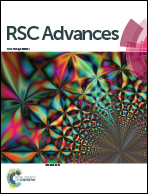Two- and four-probe field-effect and Hall mobilities in transition metal dichalcogenide field-effect transistors†
Abstract
We have fabricated WS2 and MoS2 multilayer field-effect transistors (FETs) to compare two-probe and four-probe field-effect and Hall mobility measurements. Hall mobility provides accurate information and shows the largest value, whereas field-effect mobility shows small values. The influence of contact resistance is not negligible in the two-probe field-effect mobility measurement. The current–voltage characteristics of Cr/Au (8/80 nm) contacts exhibit ohmic behavior in the WS2 multilayer FET and non-linear behavior in the MoS2 multilayer FET. Regardless of the electrical characteristics of the contacts, the field-effect mobility is much lower than the Hall mobility. Electrical contacts in the WS2 or MoS2-based FETs produce a non-discountable influence on the field-effect mobility estimation in the two-probe configuration. When the carrier concentration is not linearly dependent on gate voltage, the equivalence of field-effect and Hall mobilities does not hold. In this case, field-effect mobility provides only a rough estimate of Hall mobility.


 Please wait while we load your content...
Please wait while we load your content...